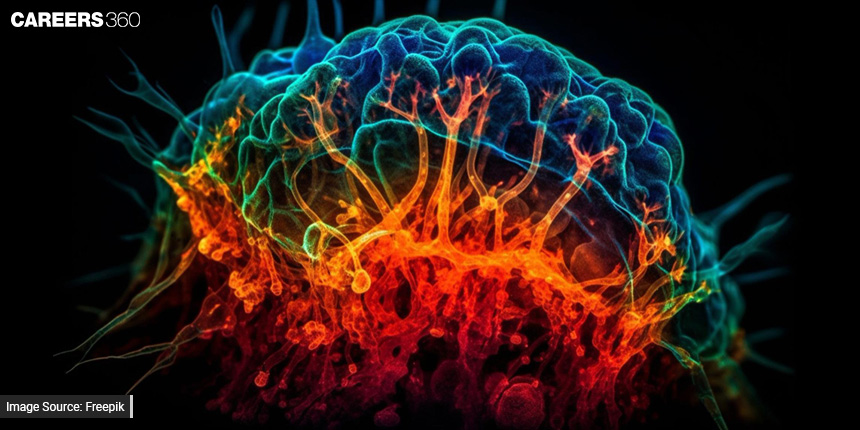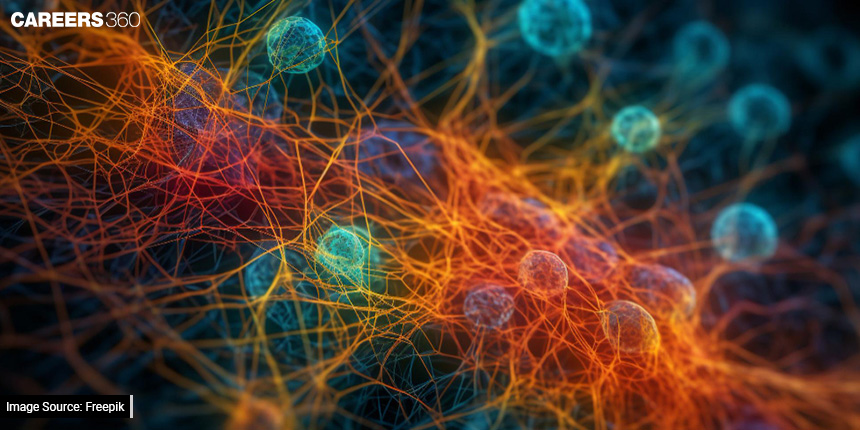How Much Of AI Is Inspired By Biological Neural Networks?
With the introduction of various platforms such as Chat GPT, working on the model of artificial intelligence, it is obvious that people are curious. The most intriguing question is about how artificial intelligence (AI) mimics humans and understands and replies like humans. Well, the functioning of the AI is dependent on the artificial neural network. This network is a highly advanced and sophisticated human-made technology that is inspired by the human brain and its neural network. You can find more details about neurons and the human neural system in the chapter Neural Control And Coordination from NCERT Class 11 Biology. Let us now understand the relationship between the brain and the neural network.
This Story also Contains
- Relationship Between The Brain And Biological Neural Networks
- Inspiration For Artificial Intelligence
- Difference Between Artificial Neural Network (Ann) And Biological Neural Network (Bnn)

Relationship Between The Brain And Biological Neural Networks
The brain which is the command centre of our body consists of billions of interconnected neurons. These neurons are specialised cells that communicate with each other through electrical and chemical signals. These neurons work together to form a network that processes information, regulates bodily processes, and supports various cognitive functions like perception, memory, and decision-making. It is necessary to understand the functions of the biological neural network to learn about how the brain is dependent on it for its functionality.
The Building Blocks Of Intelligence
At the core of every biological neural network are neurons, specialised cells that transmit electrical signals. These neurons communicate with one another through synapses, forming a vast network throughout the brain. This intricate system allows for the processing, storage, and retrieval of information, ultimately enabling various cognitive functions.
Layers Of Complexity
Similar to the layers of an intricate puzzle, the organisation of neurons in the brain follows a hierarchical pattern. This layered structure plays a crucial role in information processing. Neurons in lower layers extract simple features from sensory inputs, such as edges or colours, while those in higher layers combine these features to form more complex representations. This process of feature extraction and integration is a fundamental aspect of biological neural networks, facilitating perception and cognition.
Learning And Adaptation
The brain's ability to learn from experience and adapt to new situations is a remarkable characteristic of biological neural networks. Synaptic plasticity, the ability of synapses to strengthen or weaken their connections, plays a vital role in this process. When we learn, synapses undergo modifications, reinforcing certain connections and weakening others. This phenomenon, known as synaptic plasticity, forms the foundation for memory formation, skill acquisition, and overall cognitive flexibility.
Also check - Discover How Mathematics Helps Calculate Plot Areas Accurately
Inspiration For Artificial Intelligence
The capabilities of biological neural networks have served as a significant inspiration for the field of artificial intelligence (AI). Researchers try to replicate the brain's neural architecture to develop intelligent machines. Artificial neural networks (ANNs) are computational models designed to mimic the structure and functionality of biological neural networks. ANNs consist of interconnected nodes, or artificial neurons, organised into layers. These networks can learn from data and perform tasks such as pattern recognition, language processing, and decision-making. The factors that influence the field of artificial intelligence are as follows:
Neural Network Architecture
Artificial neural networks (ANNs) are the fundamental building blocks of many AI models. They are inspired by the structure and functionality of biological neural networks found in the human brain. ANNs consist of interconnected nodes (neurons) that process and transmit information. The arrangement of these nodes in layers, with connections between them, allows for complex computations and learning.
Learning Paradigms
Biological neural networks are capable of learning and adapting to their environments. This capacity has motivated the development of machine learning algorithms that enable AI systems to learn from data. For example, supervised learning algorithms are inspired by the way our brain processes information with labelled examples. Reinforcement learning draws inspiration from the reward-based learning observed in biological systems.
Deep Learning
Deep learning, a subset of machine learning, is heavily influenced by the structure of biological neural networks. Deep neural networks (DNNs) are composed of multiple layers of interconnected neurons, mimicking the hierarchical organisation of neurons in the brain. This architecture enables DNNs to learn complex patterns and hierarchies of information, leading to significant advancements in image recognition, natural language processing, and other AI tasks.
Feature Extraction
In biological neural networks, different layers of neurons extract features of increasing complexity from sensory inputs. This idea has been adopted in AI, where deep learning models automatically learn hierarchical representations of data. These models can identify important features and patterns at various levels of abstraction, contributing to the success of tasks such as image and speech recognition.
Plasticity And Adaptability
Biological neural networks exhibit plasticity, the ability to rewire and reorganise their connections based on experience, also known as neuroplasticity or neural plasticity. This property has inspired researchers to develop AI algorithms and architectures that can adapt to changing environments, learn new tasks, and generalise knowledge.
Difference Between Artificial Neural Network (Ann) And Biological Neural Network (Bnn)

Artificial neural networks (ANN) and biological neural networks (BNN) differ in several key aspects:
Structure
ANNs are designed with a simplified structure compared to the complex organisation of the human brain's BNN. ANNs typically consist of artificial neurons connected by weighted edges, while BNNs comprise billions of interconnected neurons with diverse types and connectivity patterns.
Processing Power
BNNs are highly parallel and can process information in parallel across their vast number of neurons, enabling complex computations and real-time responses. ANNs, while capable of parallel processing, often rely on sequential computation due to limitations in hardware or software implementation.
Energy Efficiency
BNNs are remarkably energy-efficient, utilising complex mechanisms to optimise energy consumption. In contrast, ANNs, especially large deep neural networks, require significant computational resources and energy consumption, making them less efficient compared to their biological counterparts.
Real-World Performance
BNNs have evolved over millions of years and are optimised for survival and adaptation in real-world environments. ANNs, although capable of achieving impressive results in specific tasks, often struggle with generalisation and may not perform as well in complex, dynamic real-world scenarios.
It is necessary to understand that, though AI neural networks draw inspiration from biological neural networks, they are not meant to replicate the brain's intricacies fully.
Also check - Understand How Wind Turbines Generate Electricity
Applications for Admissions are open.
As per latest syllabus. Physics formulas, equations, & laws of class 11 & 12th chapters
JEE Main Important Chemistry formulas
Get nowAs per latest syllabus. Chemistry formulas, equations, & laws of class 11 & 12th chapters
JEE Main high scoring chapters and topics
Get nowAs per latest 2024 syllabus. Study 40% syllabus and score upto 100% marks in JEE
JEE Main Important Mathematics Formulas
Get nowAs per latest syllabus. Maths formulas, equations, & theorems of class 11 & 12th chapters
